| More finds from Wimpole excavations |
| 1/9/2023 |
Our finds investigation has recently been concerned with the large number of oyster shells recovered from a number of trenches, but especially Trench 5. In the black layer nearly 150 upper oyster shells were recovered from one bag alone, plus numbers of the lower shell.
Some interesting shells are like the one shown here in the photograph - it shows two juvenile shells attached to the upper of a mature oyster. According to work by Jessica Winder in 2011 this is not that unusual. Using her guide to processing oyster shells we will attempt to analyse these finds. | | 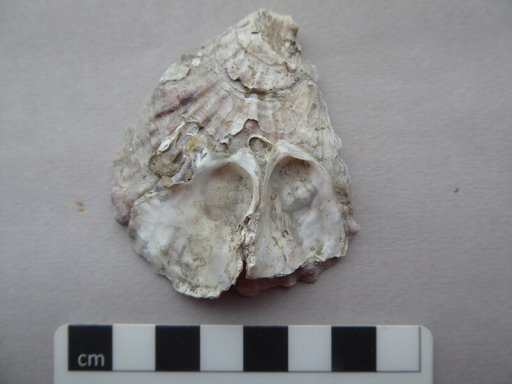 |
|
 |
| Another interesting find from Wimpole |
| 23/08/2023 |
There is an interesting situation with these finds shown in the upper photograph which are two feet from a medieval pipkin like the one shown in the lower photograph. However, the foot on the left was found on the surface of a flowerbed while the one on the right was found over a metre deep in the "black" hole. The surface find was undamaged while the deep find had been heated enough to cause the glaze to bubble in places. How did they come to be so separated?
The finds are both in late medieval Tudor Green ware, a type that has been dated to the period 1380 - 1600AD - so just what we would expect for the demolition of the old moated manor house. | | 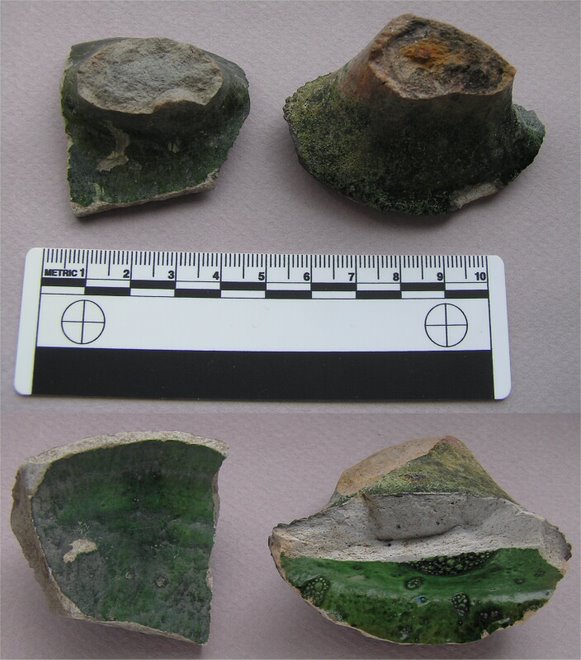 |
|
 |
| Another old find from the dark pit |
| 9/07/2023 |
| This bunghole cistern in a dark black sandy fabric probably dates to the 15th C or later. We found a similar vessel in our dig at the Ickleton Abbey site but there we found that it had a decorative fluting around the bung hole unlike the plain hole seen here. The vessel seen here has a lot of concretion on it which suggests that it had been buried for some considerable time. | | 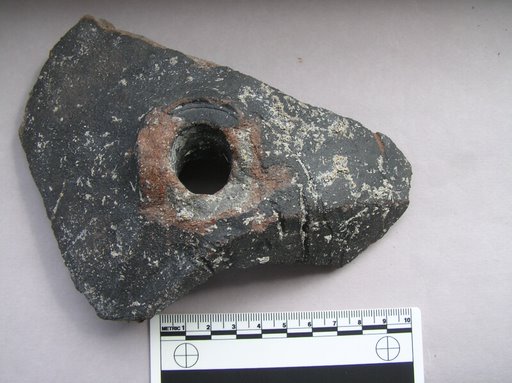 |
|
|
| This photograph shows a complete bunghole cistern dating to the same period in the late medieval period. | |  |
|
| The end of a successful excavation at Wimpole Hall |
| 29/07/2023 |
Our excavations in the parterre gardens at Wimpole Hall have finished and achieved all our objectives. The two wall we had previously uncovered in the field beyond the parterre wall do indeed go towards the house, although we cannot confirm that they abut the house itself. Our trench to seek the moat only produced a brick drainage channel, using unmortared bricks, heading east-west. However one of the trenches to the west and near the house produced a deep pit which may be part of the moat. Over 1 metre down was a burnt layer containing much broken pottery, lots of oyster shells and animal bones amongst others. The star find was a medieval colander, shown in the photograph.
The sides and rim are missing but we have 90+ percent of the base, including the three legs that supported it. The top of the base has a yellowy brown glaze while the underside is red earthenware. The drainage holes are about 0.25 inches in diameter while the surviving base is about 7 inches in diameter.
There were more interesting finds we will cover later after processing them. | | 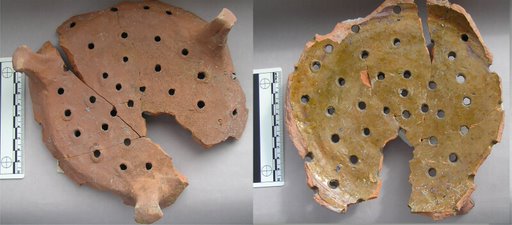 |
|
 |
| Reminder about the upcoming excavation at Wimpole |
| 8/07/2023 |
This is to remind members that our 2023 excavation takes place over the 20th - 25th July at Wimpole. The parterre garden to the north of the Hall is due to be re-modelled and so we have a rare opportunity to excavate near the house.
Our aim is to see whether the two north-south walls we uncovered when we excavated the fountain carry on beyond the garden wall and join up with the building. Also there is a hope that we may be able to find the moat of the original manor house, which we again had some hints of when we excavated the fountain site.
So far we have laid out two east-west baselines at either side of the parterre and a central north-south baseline which is aligned with the centre of the house door and the iron garden gate. We have inserted a temporary bench mark which we hope to use the OS benchmark on the church to give us an accurate height for the site
| | 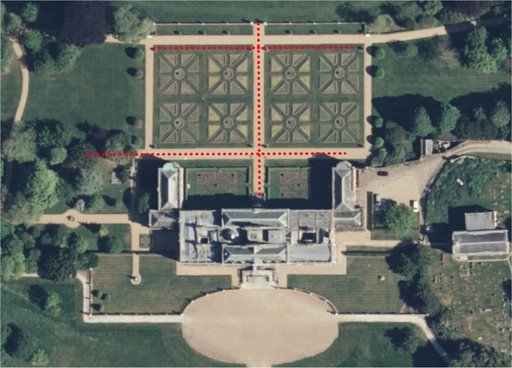 |
|
 |
| Test pitting at Wimpole 26th - 29th October |
| 26/10/2022 |
This was an exercise carried out at the request of the National Trust, following a series of geophysical surveys across Trust land due to be planted with trees. Top 20 field revealed traces of potentially Iron Age and Roman date that required confirmation by a series of test pits.
A total of 9 test pits (all 1m x 1m square) were dug at 50m intervals across the area. The first 5 pits to the north (across the presumed iron Age features) produced no real finds apart from a single piece of possible Iron Age pottery. Pits were generally excavated to 30cm before the clay base layer.
However, the 4 pits to the south revealed Roman pottery and one exposed a feature going some 50 cm deep with no obvious signs of reaching a base clay level. The test pitting, therefore, produced confirmation that the geophys results were most likely to be Roman in the south but the north is still unproven.
This field is due to be ploughed next Spring so we hope to be able to field walk it then to cover a much wider area. | |  |
|
 |
| Another local find from the waste pit |
| 15/8/2017 |
As we have processed our finds from Johnston's Pond we have found a number could be re-constructed to form a nearly complete vessel. The photograph shows a stoneware 1 gallon flagon with the embossed name of J and JE Phillips, Royston Brewery. Missing a couple of side wall pieces and the looped handle, it shows the effect of being buried with lots of rusty cans.
Robert Phillips started the business in 1725 but it was sold to Greens of Luton in 1949, although it operated as Greens wine and spirits subsidiary in 1952. It appears to have still been listed in the telephone directory as recently as 1962.
How old the flagon is cannot be determined with any confidence but the fact that the company name is embossed, not printed as was the later fashion, suggests an early 20th C date | |  |
|
 |
| More finds from Johnston's Pond |
| 25/7/2017 |
As we dig deeper at Johnston's Pond it becomes ever clearer that we are dealing with a waste tip deposited within the brick structure. Some of the finds lie beneath the collapsed brickwork and include lots of bottles and jars, rusted metal cans and so on. We even have a rusted clock and a bicycle bell!!
The photograph shows one of the bottles, still containing murky liquid. It is an example of the unusual Codd bottles, designed to hold fizzy drinks. Invented by Hiram Codd of Camberwell in 1875, it used an internal glass ball to seal its contents. Gas pressure forced the ball against a rubber ring in the neck and to pour out the contents you had to press the ball down with a special wooden tool supplied with the bottle. They were in use from 1875 to around 1930 in this country.
The embossed makers name is CRAMPTON and CO who were active in Newmarket and Sawston in the 1920's.
UPDATE: In 1861 John Crampton set up two bottling plants, one in the High Street, Sawston and the other in Park Lane, Newmarket. The Sawston plant closed in 1928 but the Newmarket one carried on into the early 1960's. | |  |
|
 |
| More news from Johnston's Pond |
| 18/7/2017 |
Another two eventful days at Johnston's Pond.
As we dug down further it became obvious that the N-S wall was actually bonded into the E-W curved wall after all. The broken brick joint was caused by the whole wall leaning inwards at the top, either as a result of pressure from the weight of the clay bank behind it or when the wall was broken. Continuing downwards, a large piece of intact brickwork came into view which looks like it might come from a corbelled roof to the structure. In amongst the demolition debris we found a number of glass vessels - some unbroken like that shown in the photograph with its stopper intact and some contents visible. It is an Owbridge's Lung Tonic bottle - this cough medicine was invented in 1874 but carried on being made until 1969 - so not much use as dating evidence!! The rest of the glassware has a very 1940 - 50's look about it and this may be the period when the structure was demolished. But by whom? If this mid 20th C date is correct why are there not records of the structure there.
We are carrying on, although the depth of the trench may force us to stop. There is certainly no sign yet of an outlet. | |  |
|
| More mysteries at Johnston's Pond |
| 11/7/2017 |
Our dig of 2 weeks ago produced 2 walls and several unanswered questions, therefore we were out at Johnston's Pond again seeking more information. What we actually got were more questions!!
We carried on digging near the curved wall (which runs east-west) and its presumed return wall running north-south. However, as the photographs shows, the curved wall cuts through the north-south wall. There is no mortar sealing the joins between the two so the structure would not have been water-tight. In addition a section of joined-up brickwork lying in the bottom of the trench was not a floor.
This leaves us with several questions - does the north-south wall carry on south of the curved wall? If so, how far? Also the north-south wall itself is curved as the angled bricks in the photo show. What lies below the block of bricks - is there a floor further down?
The net result is that we have more work to do and hope to carry it out this coming weekend. If you are interested do come and see the mystery wall - we might have an answer then. | |  |
|
 |
| Another successful dig at Wimpole |
| 25/6/2017 |
Well, what a successful weekend. After hacking our way through the jungle we started investigating the isolated bricks on Saturday. This revealed a debris field of lots of bricks, broken ones as well as complete ones, which appear to be late 18th/early 19th C in date. As we dug down we started to reveal the beginnings of a wall in the middle of the cut in the pond bank. More bricks to the north of this on the edge of the bank leading down into the pond were more jumbled but appeared to be another wall.
Sunday was very eventful - the southern wall kept going down (12 courses of brick to date) and surprised us by being curved lower down (see the photograph) with a return wall on the eastern side. This is a substantial piece of work and we can only guess how deep the brickwork goes. No sign yet of any outflow pipe, but we are still well above the pond water level so not unexpected. Angus Wainwright will visit to decide how to proceed - we are already 1 metre below the bottom of the original cut. More information as it arrives. | |  |
|
|
| While digging we were astonished by the number of butterflies, such as marbled whites, meadow browns etc, flying around. The photo shows how camouflaged they are set against a meadow grassland background. There were also quantities of pyramidal orchids flowering together with a few bee orchids (see the Facebook page). It is so good to see such a varied environment with its attendant wildlife doing so well at Wimpole. | |  |
|
 |
| 2014 excavations at Wimpole |
Well, the time has come, our excavations start this weekend (26th July) and finish on Sunday 3rd August. It looks as though it is going to be as warm as last year so here is a reminder that members should take precautions due to the conditions.
An example from last year shows Legionnaire Tim at work with his precautions in place.
Please cover up, especially when the sun is at its hottest around midday, and use sun block if necessary. Most importantly take plenty of fluid.
Let us hope we can achieve the goals we have set ourselves for this year and look forward to seeing you there. Please come and see us even if you cannot be excavating.
| |  |
|
| 2014 excavations at Wimpole |
Well, another hot and sunny period characterised our 2014 excavations - in many ways a replica of our 2013 season. The results, as always, answered some questions but created even more. So what can we say in retrospect?
Firstly we did not find the water pipe (see below), or one of its couplings. A 4m x 1m trench placed across the line of the feature seen on the geophysics trace, down to a depth of 1.2m, did not reveal either the physical water pipe itself, or any real sign of a foundation trench. A subsequent metal detector scan of the probable line of the pipe produced multiple targets. Some of these did not always match the expected line of the pipe. So this remains a project for future work.
A nearby 1m x 1m test pit placed over an area of magnetic disturbance, did not produce any sign of a possible observation post said to be hereabouts.
Down in the field to the north of the Brick End cottages, we investigated a moat-like feature. Here we found the western arm of the "moat". This turned out to be a very shallow, small cut, underlain by a thick, black clay lining. The eastern arm of the moat was not found but signs of coprolite digging were everywhere. These revealed greensand lumps and plentiful coprolites themselves. Various cut features, perhaps evidence for processing coprolites, were recorded. A 1m x 1m test pit nearby did not disclose a possible house site shown on early maps.
Next we investigated possible house sites in the paddocks near Home Farm, shown here in the photo. One 1m x 1m test pit on a hump was essentially blank but two others in lower ground uncovered amounts of bricks, butchered bones and cobbles. Future work will be needed, possibly involving a larger excavation, to determine the exact nature of this feature.
Finally, many thanks to the diggers who sweltered in the hot sun to achieve our excavation plan and also other helpers back at our base tent, who washed finds and talked to an interested public.
| |  |
|
 |
| 2014 Excavations at Wimpole |
| During the summer of 2014, CAFG undertook a series of excavations around the Wimpole estate in order to investigate features identified by geophysical survey. read more |
|
 |
|
| 23 September 2011 |
| Finding clay tobacco pipe stems with the maker's name on them is fairly unusual but one has been recovered from Wimpole during the 2011 excavation. This pipe was researched and found to be most probably made in Cambridge by Ann Cleaver (or Cleever) sometime in the mid 19th C. For more information see this article
|
|
|
| 27th August 2011 |
| We have now finished the survey work on site and the trenches will be filled in next week. The many pieces of yellow ceramic floor tile from the 18th century extension have been kept to allow us to play jigsaws to determin the size of the slabs. More finds have been photographed including these two ceramic balls which could be early 'marbles'. | |  |
|
|
| 24th August 2011 |
| We have yet to finish the site survey, problems with GPS equipment have held us up. Hopefully the site work will be completed this week and the trenches will be backfilled next week. There are still plenty of finds to be washed and identified at Barhill on wednesday evenings. | | 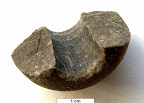 |
|
|
| 16th August 2011 |
| Two weeks after we stopped excavating and we have nearly finished all drawing and photography. This has been the year of the wine bottle, from one context alone there are well in excess of 30 bottle necks of early 18th century date. The photos in the gallery show a very small selection of other finds - more to come soon. | |  |
|
|
| 7th August 2011 |
| We are begining the long task of analysing the finds from this year's excavation. There is a lot of glass, window and vessel, including a nice rim of a glass with an engraved pattern - a poor photo at the moment but we will take some better ones soon. | |  |
|
|
| 1st August 2011 |
| After nine days of excavation we have completed what we had hoped to do this year on Mr Radford's house. There is clear evidence of medieval occupation, pottery and possibly a large clunch chalk wall, replaced by a 17th century timberframed long house on a red brick wall, and then in the early 18th century an extension to the west re-using the earlier clunch foundation. The south end of the 17th cent. house has a brick gable end with an inglenook fireplace. Now comes all the work sorting finds and writing an interpretation. Perhaps now like the 17th cent. occupiers we can have a glass or two of wine! | |  |
|
|
| 30th July 2011 |
| The picture used yesterday showed the red brick wall of the 17th century house. We now think this foundation was re-used, and sits on a large clunch foundation built in the Medieval period. So our house built with red brick walls is now seen to partly overlie an earlier clunch wall. Very nice to see a new member making an interesting find in today's picture. | |  |
|
 |
| More finds from Wimpole |
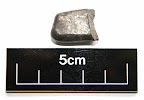 | | More finds from previous work - as you know we have recovered a range of metal objects during our Wimpole project and one is shown in this photograph. It is part of a "hack" silver ingot, Viking of 9th century date.
The Viking economy made use of silver bullion and so coins or jewellery were often melted down into ingots of various sizes. It was important that the purity of the metal could be tested and one method was to check the hardness of the alloy by nicking or pecking it. It also revealed any plating used to disguise base metal. If you are really lucky they have Runes inscribed on them, unfortunately our example has no markings.
There are few physical traces of Viking influence in our part of East Anglia so this is a significant find. |
|
 |
|
| 29 July 2011 |
| We have now uncovered the massive brickwork of the gable end of the house and and projecting into the room (north) is brickwork forming the east side of an inglenook fireplace. | |  |
|
|
| 28 July 2011 |
| The red brick walls of the 17th century house have been found plus a large extension on the west side built with a clunch wall and clunch under floor (clunch is a hard chalk) layers relating to the underlying medieval house are now appearing. | |  |
|
|
| 27th July 2011 |
| The walls and floors of the 17th century house are now showing and we have discovered a large, slightly later, extension on the western side. New finds include some interesting, hopefully datable pottery.
| |  |
|
|
| 25th July 2011 |
| We are underway with our excavation and here is one of our early finds, a ceramic ball. Is this a toy or for a board game? | | 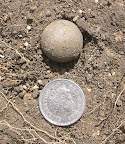 |
|
|
| 23rd July 2011 |
| The excavation begins - briefing for diggers on day one. | | 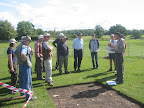 |
|
 |
| Excavations at Wimpole Hall |
|